1. The payback period of a project is the number of years it takes for the cumulative cash flows of the project to equal the initial investment. The payback rule states that projects with payback periods below a specified cutoff, such as 3 years, should be accepted.
2. While payback period is an easy metric to calculate, it ignores the timing of cash flows and does not consider the project's full cash flow stream or the opportunity cost of capital. As a result, projects with higher NPVs may be rejected in favor of those with shorter payback periods.
3. The example shows three projects, two of which have a 2-year payback but different NPVs when discounted at































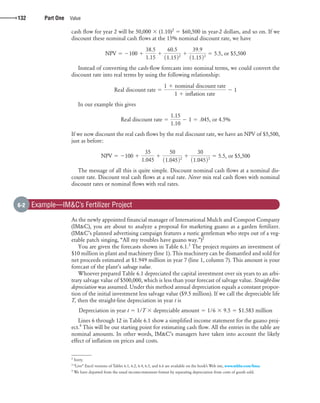



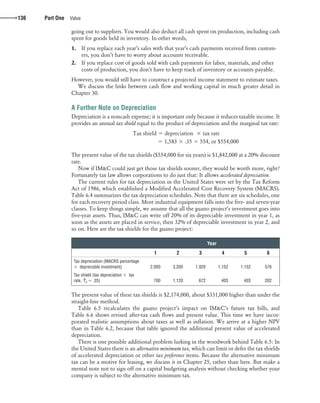































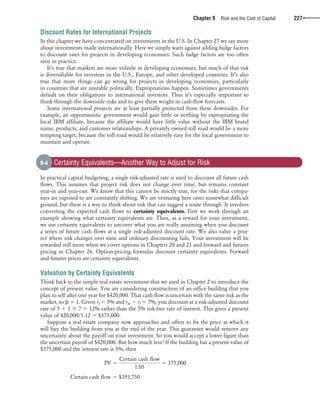




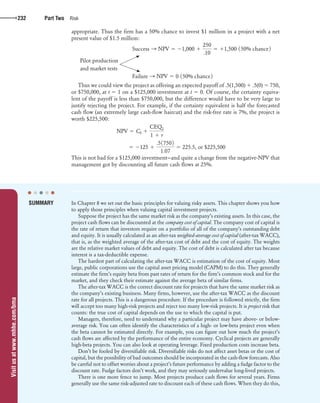
















![confirming pages
402 Part Five Payout Policy and Capital Structure
Now suppose the company announces that instead of paying a cash dividend in year
1, it will spend the same money repurchasing its shares in the open market. The total
expected cash flows to shareholders (dividends and cash from stock repurchase) are
unchanged at $1,000. So the total value of the equity also remains at $1,000/.10 ϭ $10,000.
This is made up of the value of the $1,000 received from the stock repurchase in year 1
(PVrepurchase ϭ $1,000/1.1 ϭ $909.1) and the value of the $1,000-a-year dividend starting
in year 2 [PVdividends ϭ $1,000/(.10 ϫ 1.1) ϭ $9,091]. Each share continues to be worth
$10,000/100 ϭ $100 just as before.
Think now about those shareholders who plan to sell their stock back to the company.
They will demand a 10% return on their investment. So the expected price at which the
firm buys back shares must be 10% higher than today’s price, or $110. The company spends
$1,000 buying back its stock, which is sufficient to buy $1,000/$110 ϭ 9.09 shares.
The company starts with 100 shares, it buys back 9.09, and therefore 90.91 shares
remain outstanding. Each of these shares can look forward to a dividend stream of
$1,000/90.91 ϭ $11 per share. So after the repurchase shareholders have 10% fewer shares,
but earnings and dividends per share are 10% higher. An investor who owns one share
today that is not repurchased will receive no dividends in year 1 but can look forward to
$11 a year thereafter. The value of each share is therefore 11/(.1 ϫ 1.1) ϭ $100.
Our example illustrates several points. First, other things equal, company value is unaf-
fected by the decision to repurchase stock rather than to pay a cash dividend. Second, when
valuing the entire equity you need to include both the cash that is paid out as dividends and
the cash that is used to repurchase stock. Third, when calculating the cash flow per share, it
is double counting to include both the forecasted dividends per share and the cash received
from repurchase (if you sell back your share, you don’t get any subsequent dividends). Fourth,
a firm that repurchases stock instead of paying dividends reduces the number of shares out-
standing but produces an offsetting increase in subsequent earnings and dividends per share.
MM said that dividend policy is irrelevant because it does not affect shareholder value.
MM did not say that payout should be random or erratic; for example, it may change over
the life cycle of the firm. A young growth firm pays out little or nothing, to maximize the
cash flow available for investment. As the firm matures, positive-NPV investment oppor-
tunities are harder to come by and growth slows down. There is cash available for payout
to shareholders. At some point the firm commits to pay a regular dividend. It may also
repurchase shares. In old age, profitable growth opportunities disappear, and payout may
become much more generous.
Of course MM assumed absolutely perfect and efficient capital markets. In MM’s world,
everyone is a rational optimizer. The right-wing payout party points to real-world imper-
fections that could make high dividend payout ratios better than low ones. There is a
natural clientele for high-payout stocks, for example. Some financial institutions are legally
restricted from holding stocks lacking established dividend records.21
Trusts and endow-
ment funds may prefer high-dividend stocks because dividends are regarded as spendable
“income,” whereas capital gains are “additions to principal.”
There is also a natural clientele of investors, such as the elderly, who look to their stock
portfolios for a steady source of cash to live on.22
In principle, this cash could be easily
21
Most colleges and universities are legally free to spend capital gains from their endowments, but they usually restrict spending
to a moderate percentage that can be covered by dividends and interest receipts.
22
See, for example, J. R. Graham and A. Kumar, “Do Dividend Clienteles Exist? Evidence on Dividend Preferences of Retail
Investors,” Journal of Finance 61 (June 2006), pp. 1305–1336; and M. Baker, S. Nagel and J. Wurgler, “The Effect of Dividends on
Consumption,” Brookings Papers on Economic Activites (2007), pg 277–291.
16-6 The Rightists
bre30735_ch16_391-417.indd 402bre30735_ch16_391-417.indd 402 12/8/09 2:28:07 PM12/8/09 2:28:07 PM](https://image.slidesharecdn.com/fin-2book-170226090137/85/Fin-2-book-90-320.jpg)















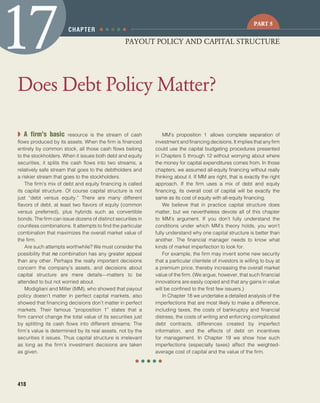





![confirming pages
424 Part Five Payout Policy and Capital Structure
money. The payoff on the investment varies with Macbeth’s operating income, as shown
in Table 17.3. This is exactly the same set of payoffs as the investor would get by buying
one share in the levered company. [Compare the last two lines of Tables 17.2 and 17.3.]
Therefore, a share in the levered company must also sell for $10. If Macbeth goes ahead
and borrows, it will not allow investors to do anything that they could not do already, and
so it will not increase value.”
The argument that you are using is exactly the same as the one MM used to prove
proposition 1.
Consider now the implications of MM’s proposition 1 for the expected returns on Macbeth
stock:
Current Structure:
All Equity
Proposed Structure:
Equal Debt and Equity
Expected earnings per share ($) 1.50 2.00
Price per share ($) 10 10
Expected return on share (%) 15 20
Leverage increases the expected stream of earnings per share but not the share price. The
reason is that the change in the expected earnings stream is exactly offset by a change in
the rate at which the earnings are discounted. The expected return on the share (which for
a perpetuity is equal to the earnings–price ratio) increases from 15% to 20%. We now show
how this comes about.
The expected return on Macbeth’s assets rA is equal to the expected operating income
divided by the total market value of the firm’s securities:
Expected return on assets 5 rA 5
expected operating income
market value of all securities
We have seen that in perfect capital markets the company’s borrowing decision does
not affect either the firm’s operating income or the total market value of its securities.
Therefore the borrowing decision also does not affect the expected return on the firm’s
assets rA.
Suppose that an investor holds all of a company’s debt and all of its equity. This investor
is entitled to all the firm’s operating income; therefore, the expected return on the portfolio
is just rA.
17-2 Financial Risk and Expected Returns
Operating Income ($)
500 1,000 1,500 2,000
Earnings on two shares ($) 1 2 3 4
Less interest at 10% ($) 1 1 1 1
Net earnings on investment ($) 0 1 2 3
Return on $10 investment (%) 0 10 20 30
Expected
outcome
◗ TABLE 17.3
Individual investors
can replicate Macbeth’s
leverage.
bre30735_ch17_418-439.indd 424bre30735_ch17_418-439.indd 424 12/8/09 2:30:17 PM12/8/09 2:30:17 PM](https://image.slidesharecdn.com/fin-2book-170226090137/85/Fin-2-book-112-320.jpg)







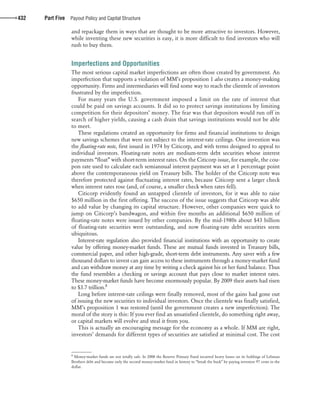




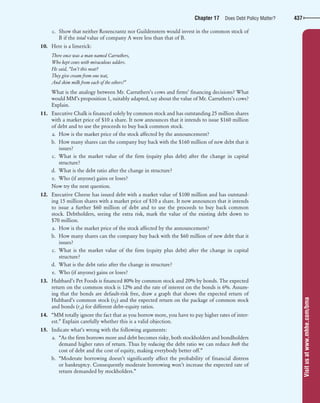
![Visitusatwww.mhhe.com/bma
confirming pages
438 Part Five Payout Policy and Capital Structure
16. Each of the following statements is false or at least misleading. Explain why in each case.
a. “A capital investment opportunity offering a 10% DCF rate of return is an attractive
project if it can be 100% debt-financed at an 8% interest rate.”
b. “The more debt the firm issues, the higher the interest rate it must pay. That is one
important reason why firms should operate at conservative debt levels.”
17. Can you invent any new kinds of debt that might be attractive to investors? Why do you
think they have not been issued?
18. Imagine a firm that is expected to produce a level stream of operating profits. As leverage
is increased, what happens to:
a. The ratio of the market value of the equity to income after interest?
b. The ratio of the market value of the firm to income before interest if (i) MM are right
and (ii) the traditionalists are right?
19. Archimedes Levers is financed by a mixture of debt and equity. You have the following
information about its cost of capital:
rE ϭ rD ϭ 12% rA ϭ
E ϭ 1.5 D ϭ A ϭ
rf ϭ 10% rm ϭ 18% D/V ϭ .5
Can you fill in the blanks?
20. Look back to Problem 19. Suppose now that Archimedes repurchases debt and issues
equity so that D/V ϭ .3. The reduced borrowing causes rD to fall to 11%. How do the
other variables change?
21. Omega Corporation has 10 million shares outstanding, now trading at $55 per share.
The firm has estimated the expected rate of return to shareholders at about 12%. It
has also issued long-term bonds at an interest rate of 7%. It pays tax at a marginal rate
of 35%.
a. What is Omega’s after-tax WACC?
b. How much higher would WACC be if Omega used no debt at all? (Hint: For this
problem you can assume that the firm’s overall beta [A] is not affected by its capital
structure or the taxes saved because debt interest is tax-deductible.)
22. Gamma Airlines has an asset beta of 1.5. The risk-free interest rate is 6%, and the market
risk premium is 8%. Assume the capital asset pricing model is correct. Gamma pays taxes
at a marginal rate of 35%. Draw a graph plotting Gamma’s cost of equity and after-tax
WACC as a function of its debt-to-equity ratio D/E, from no debt to D/E ϭ 1.0. Assume
that Gamma’s debt is risk-free up to D/E ϭ .25. Then the interest rate increases to 6.5% at
D/E ϭ .5, 7% at D/E ϭ .8, and 8% at D/E ϭ 1.0. As in Problem 21, you can assume that
the firm’s overall beta (A) is not affected by its capital structure or the taxes saved because
debt interest is tax-deductible.
CHALLENGE
23. Consider the following three tickets: ticket A pays $10 if _______ is elected as president,
ticket B pays $10 if _______ is elected, and ticket C pays $10 if neither is elected. (Fill in the
blanks yourself.) Could the three tickets sell for less than the present value of $10? Could
they sell for more? Try auctioning off the tickets. What are the implications for MM’s
proposition 1?
24. People often convey the idea behind MM’s proposition 1 by various supermarket analo-
gies, for example, “The value of a pie should not depend on how it is sliced,” or, “The cost
of a whole chicken should equal the cost of assembling one by buying two drumsticks, two
wings, two breasts, and so on.”
bre30735_ch17_418-439.indd 438bre30735_ch17_418-439.indd 438 12/8/09 2:30:21 PM12/8/09 2:30:21 PM](https://image.slidesharecdn.com/fin-2book-170226090137/85/Fin-2-book-126-320.jpg)





![confirming pages
444 Part Five Payout Policy and Capital Structure
Our imaginary financial surgery on Merck provides the perfect illustration of the prob-
lems inherent in this “corrected” theory. That $350 million came too easily; it seems
to violate the law that there is no such thing as a money machine. And if Merck’s
stockholders would be richer with $4,943 million of corporate debt, why not $5,943
or $15,943 million? At what debt level should Merck stop borrowing? Our formula
implies that firm value and stockholders’ wealth continue to go up as D increases. The
optimal debt policy appears to be embarrassingly extreme. All firms should be 100%
debt-financed.
MM were not that fanatical about it. No one would expect the formula to apply at
extreme debt ratios. There are several reasons why our calculations overstate the value
of interest tax shields. First, it’s wrong to think of debt as fixed and perpetual; a firm’s
ability to carry debt changes over time as profits and firm value fluctuate. Second,
many firms face marginal tax rates less than 35%. Third, you can’t use interest tax
shields unless there will be future profits to shield—and no firm can be absolutely sure
of that.
But none of these qualifications explains why companies like Merck survive and thrive
at low debt ratios. It’s hard to believe that Merck’s financial managers are simply missing
the boat.
A conservative debt policy can of course be great comfort when a company suffers a sud-
den adverse shock. For Merck, that shock came in September 2004, when it became clear
that its blockbuster painkiller Vioxx increased the risk of heart attacks in some patients.
When Merck withdrew Vioxx from the market, it lost billions of dollars in future revenues
and had to spend or set aside nearly $5 billion for legal costs and settlements. Yet the
company’s credit rating was not harmed, and it retained ample cash flow to fund all its
investments, including research and development, and to maintain its regular dividend. But
if Merck was that strong financially after the loss of Vioxx, was its debt policy before the
loss excessively conservative? Why did it pass up the opportunity to borrow a few billion
more (as in Table 18.3[b]), thus substituting tax-deductible interest for taxable income to
shareholders?
We seem to have argued ourselves into a blind alley. But there may be two ways out:
1. Perhaps a fuller examination of the U.S. system of corporate and personal taxation will
uncover a tax disadvantage of corporate borrowing, offsetting the present value of the
interest tax shield.
2. Perhaps firms that borrow incur other costs—bankruptcy costs, for example.
We now explore these two escape routes.
When personal taxes are introduced, the firm’s objective is no longer to minimize the corpo-
rate tax bill; the firm should try to minimize the present value of all taxes paid on corporate
income. “All taxes” include personal taxes paid by bondholders and stockholders.
Figure 18.1 illustrates how corporate and personal taxes are affected by leverage. Depend-
ing on the firm’s capital structure, a dollar of operating income will accrue to investors
either as debt interest or equity income (dividends or capital gains). That is, the dollar can
go down either branch of Figure 18.1.
Notice that Figure 18.1 distinguishes between Tp, the personal tax rate on interest, and
TpE, the effective personal tax rate on equity income. This rate can be well below TP,
depending on the mix of dividends and capital gains realized by shareholders. The top
marginal rate on dividends and capital gains is now (2009) only 15% while the top rate on
18-2 Corporate and Personal Taxes
bre30735_ch18_440-470.indd 444bre30735_ch18_440-470.indd 444 12/15/09 4:03:10 PM12/15/09 4:03:10 PM](https://image.slidesharecdn.com/fin-2book-170226090137/85/Fin-2-book-132-320.jpg)













































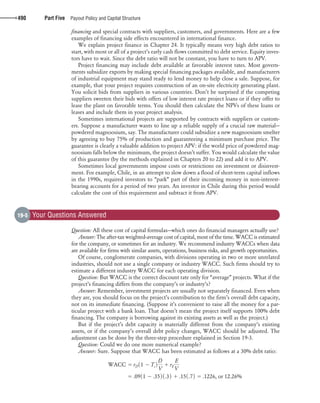
















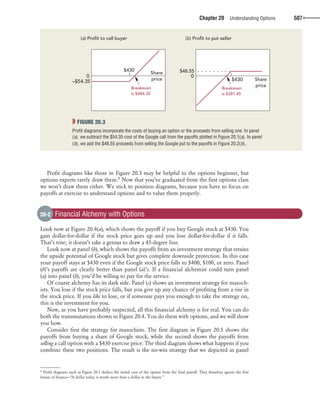

![confirming pages
Chapter 20 Understanding Options 509
there is no gain without pain. The cost of insuring yourself against loss is the amount that
you pay for a put option on Google stock with an exercise price of $430. In September 2008
the price of this put was $48.55. This was the going rate for financial alchemists.
We have just seen how put options can be used to provide downside protection. We
now show you how call options can be used to get the same result. This is illustrated in
row 2 of Figure 20.6. The first diagram shows the payoff from placing the present value of
$430 in a bank deposit. Regardless of what happens to the price of Google stock, your bank
deposit will pay off $430. The second diagram in row 2 shows the payoff from a call option
on Google stock with an exercise price of $430, and the third diagram shows the effect of
combining these two positions. Notice that, if the price of Google stock falls, your call is
worthless, but you still have your $430 in the bank. For every dollar that Google stock price
rises above $430, your investment in the call option pays off an extra dollar. For example,
if the stock price rises to $500, you will have $430 in the bank and a call worth $70. Thus
you participate fully in any rise in the price of the stock, while being fully protected against
any fall. So we have just found another way to provide the downside protection depicted
in panel (b) of Figure 20.4.
These two rows of Figure 20.6 tell us something about the relationship between a call
option and a put option. Regardless of the future stock price, both investment strategies
provide identical payoffs. In other words, if you buy the share and a put option to sell it for
$430, you receive the same payoff as from buying a call option and setting enough money
aside to pay the $430 exercise price. Therefore, if you are committed to holding the two
packages until the options expire, the two packages should sell for the same price today.
This gives us a fundamental relationship for European options:
Value of call 1 present value of exercise price 5 value of put 1 share price
To repeat, this relationship holds because the payoff of
Buy call, invest present value of exercise price in safe asset8
is identical to the payoff from
Buy put, buy share
8
The present value is calculated at the risk-free rate of interest. It is the amount that you would have to invest today in a bank
deposit or Treasury bills to realize the exercise price on the option’s expiration date.
$430
Buy share
Your
payoff
Future
stock
price
$430
Sell call
Your
payoff
Future
stock
price
$430
No upside
Your
payoff
Future
stock
price
+ =
◗ FIGURE 20.5
You can use options to create a strategy where you lose if the stock price falls but do not gain if it rises (strategy [c] in Figure 20.4).
bre30735_ch20_502-524.indd 509bre30735_ch20_502-524.indd 509 12/15/09 4:05:33 PM12/15/09 4:05:33 PM](https://image.slidesharecdn.com/fin-2book-170226090137/85/Fin-2-book-197-320.jpg)
![confirming pages
510 Part Six Options
This basic relationship among share price, call and put values, and the present value of the
exercise price is called put–call parity.9
Put–call parity can be expressed in several ways. Each expression implies two investment
strategies that give identical results. For example, suppose that you want to solve for the
value of a put. You simply need to twist the put–call parity formula around to give
Value of put 5 value of call 1 present value of exercise price 2 share price
From this expression you can deduce that
Buy put
is identical to
Buy call, invest present value of exercise price in safe asset, sell share
In other words, if puts are not available, you can get exactly the same payoff by buying calls,
putting cash in the bank, and selling shares.
9
Put–call parity holds only if you are committed to holding the options until the final exercise date. It therefore does not hold for
American options, which you can exercise before the final date. We discuss possible reasons for early exercise in Chapter 21. Also
if the stock makes a dividend payment before the final exercise date, you need to recognize that the investor who buys the call
misses out on this dividend. In this case the relationship is
Value of call 1 present value of exercise price 5 value of put 1 share price 2 present value of dividend
$430
Buy share
Your
payoff
Future
stock
price
$430
Buy put
Your
payoff
Future
stock
price
$430
Downside
protection
Downside
protection
Your
payoff
Future
stock
price
+ =
$430
$430
Bank deposit paying $430
Your
payoff
Future
stock
price
$430
Buy call
Your
payoff
Future
stock
price
$430
Your
payoff
Future
stock
price
+ =
◗ FIGURE 20.6
Each row in the figure shows a different way to create a strategy where you gain if the stock price rises but are protected on the
downside (strategy [b] in Figure 20.4).
bre30735_ch20_502-524.indd 510bre30735_ch20_502-524.indd 510 12/15/09 4:05:33 PM12/15/09 4:05:33 PM](https://image.slidesharecdn.com/fin-2book-170226090137/85/Fin-2-book-198-320.jpg)













